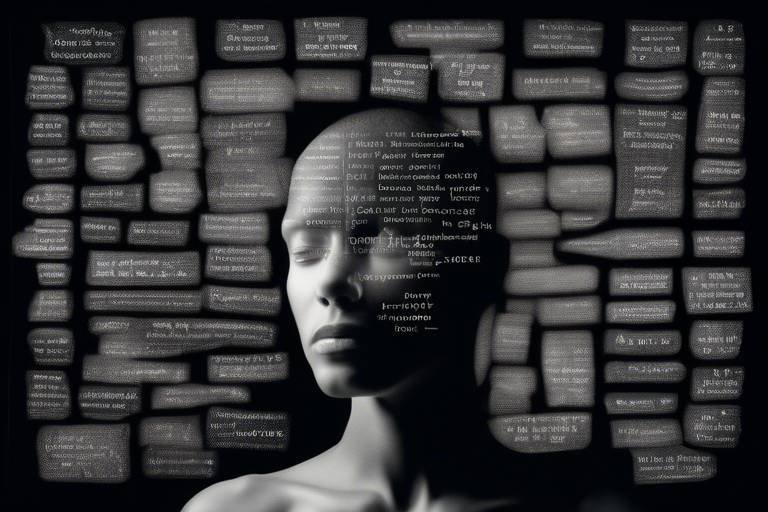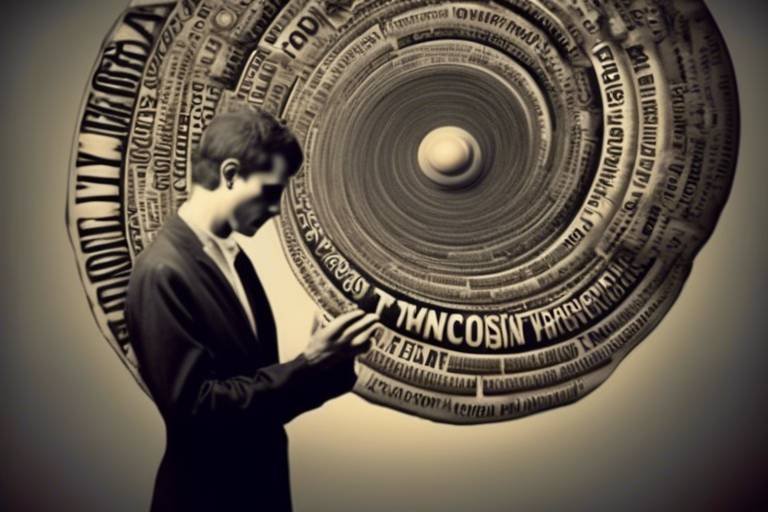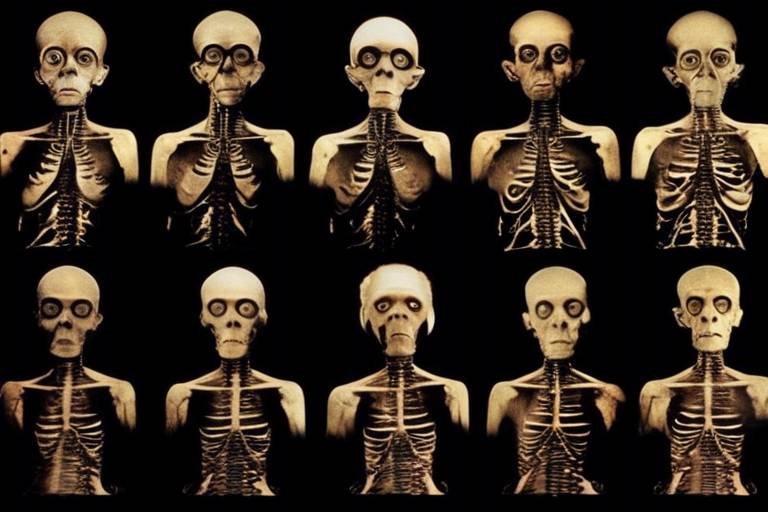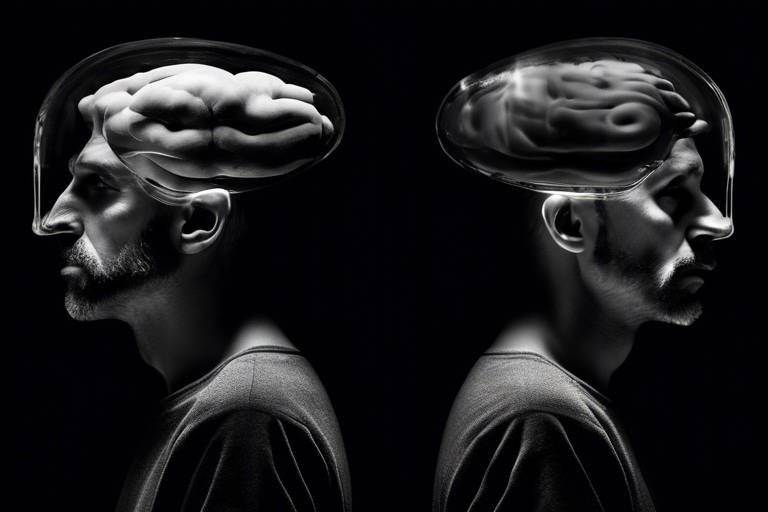Understanding Altered States of Consciousness
Have you ever experienced a moment where time seemed to stand still, or perhaps felt a deep connection to the universe around you? These moments are often described as altered states of consciousness (ASCs), which can offer fascinating insights into the depths of human experience. In this article, we will explore the intricate world of ASCs, diving into their definitions, types, and the profound implications they hold for our understanding of psychology and human experience.
Altered states of consciousness are not just a fringe topic reserved for mystics and philosophers; they are a significant part of our everyday lives. Whether through dreams, meditation, or even the effects of substances, ASCs can provide unique perspectives and experiences that differ dramatically from our normal waking state. They can be enlightening, therapeutic, or even transformative, allowing us to transcend the mundane and explore the vast landscapes of our minds.
In this exploration, we will delve into the science behind ASCs, examining how they are defined and categorized. We will look at various types of ASCs, including natural occurrences like sleep and dreams, as well as those induced by meditation and psychoactive substances. Each type has its own unique characteristics and implications for our mental and emotional well-being.
Moreover, we will investigate the cultural significance of ASCs, as different societies have developed their own interpretations and practices surrounding these states. From shamanic rituals to modern therapeutic applications, the ways in which ASCs are understood and utilized can vary widely, reflecting the rich tapestry of human experience.
Finally, we will touch upon the therapeutic potential of altered states, exploring how they are being integrated into modern psychology and mental health treatments. With a growing body of research supporting their benefits, ASCs may hold the key to unlocking new pathways for healing and personal growth.
So, are you ready to embark on this journey into the fascinating world of altered states of consciousness? Buckle up, as we navigate through the intricate definitions, types, and cultural perspectives that shape our understanding of these extraordinary mental states!
- What are altered states of consciousness?
ASCs are mental states that differ significantly from the normal waking state, often characterized by changes in perception, emotion, and thought processes.
- How can one achieve an altered state of consciousness?
ASCs can be achieved through various means, including meditation, sleep, dreams, and the use of psychoactive substances.
- What are the benefits of altered states?
Many people find that ASCs can lead to enhanced creativity, emotional healing, and a deeper understanding of oneself and the universe.
- Are altered states safe?
While many ASCs are safe and beneficial, some can pose risks, especially when induced by substances. It's essential to approach them with caution and awareness.

Defining Altered States
Altered states of consciousness (ASCs) are fascinating phenomena that encompass a wide range of experiences that deviate from our typical waking state. Imagine stepping into a world where your perceptions shift, your thoughts flow differently, and your sense of self may even dissolve—this is the essence of ASCs. These states can arise from various triggers, whether they be natural, such as sleep or meditation, or induced through substances like drugs. The key characteristic that defines ASCs is that they significantly alter the usual patterns of thought, emotion, and awareness.
To truly grasp the concept of ASCs, it's essential to understand how they contrast with our ordinary consciousness. In our daily lives, we operate within a framework of clear, logical thought processes and consistent self-awareness. ASCs, however, can disrupt this framework, leading to experiences that are often described as surreal or transcendent. For instance, during deep meditation, individuals may report feeling a profound sense of unity with the universe, a state that starkly contrasts with the mundane concerns of everyday life.
There are several definitions of ASCs, but they generally encompass the following characteristics:
- Altered Perception: Sensory experiences may become intensified or distorted, leading to a heightened awareness of colors, sounds, and even emotions.
- Changes in Thought Patterns: The flow of thoughts may become more fluid, creative, or even chaotic, allowing for insights that are not typically accessible in a normal state.
- Altered Sense of Time: Many individuals report that time seems to stretch or compress during ASCs, leading to a feeling of timelessness.
- Transcendence of Self: A common experience in ASCs is the dissolution of the ego, where individuals feel a sense of oneness with the universe or a connection to something greater than themselves.
Understanding ASCs also requires a look at their implications for human experience and psychology. They can serve as gateways to profound insights and personal transformation. From a psychological perspective, ASCs can provide therapeutic benefits, allowing individuals to confront deep-seated emotions or traumas in a safe environment. This transformative potential is part of what makes studying ASCs so compelling.
In summary, altered states of consciousness are not merely unusual experiences; they are profound journeys into the depths of the human psyche. By exploring these states, we can gain invaluable insights into the nature of consciousness itself, revealing the complexities and wonders of the human mind. Whether through meditation, dreams, or other means, understanding ASCs opens up a world of possibilities for personal growth and healing.

Types of Altered States
Altered states of consciousness (ASCs) can manifest in a variety of ways, each offering unique experiences and insights into the human mind. Understanding these different types can help us appreciate the vast landscape of consciousness and its potential for personal growth and healing. Generally, ASCs can be categorized into two main types: those induced by natural processes and those brought about by external substances. Let’s take a closer look at these categories.
Natural altered states often arise from practices such as meditation, sleep, and even dreaming. For instance, during deep sleep, our brain waves slow down significantly, allowing for restorative processes that are essential for mental and physical well-being. Similarly, meditation can lead to states where the mind is calm yet highly alert, providing a sense of clarity and peace. These natural states are not merely passive experiences; they actively engage our cognitive functions and can lead to profound personal insights.
On the other hand, we have drug-induced altered states, which can result from the consumption of various psychoactive substances. These substances can dramatically shift our perceptions, emotions, and thoughts, often leading to experiences that feel otherworldly. For example, substances like psilocybin (found in magic mushrooms) or LSD can create intense visual and auditory hallucinations, while also prompting deep introspection. However, the effects can vary widely based on the individual, the dosage, and the setting in which the substance is consumed.
To further illustrate the differences between these types of altered states, consider the following table:
| Type of Altered State | Inducing Method | Common Experiences |
|---|---|---|
| Natural ASCs | Meditation, Sleep, Daydreaming | Deep relaxation, Enhanced focus, Insights |
| Drug-Induced ASCs | Psychoactive Substances | Hallucinations, Altered perception of time, Emotional release |
In addition to these two broad categories, there are specific practices that can lead to altered states, each with its own unique characteristics. For instance, mindfulness meditation focuses on being present in the moment, which can induce a state of heightened awareness and tranquility. In contrast, transcendental meditation involves the use of a mantra to facilitate a deep state of relaxation, often resulting in profound shifts in consciousness.
Moreover, the cultural significance of ASCs cannot be overlooked. Various cultures have developed their own methods for inducing altered states, often for spiritual or healing purposes. For example, shamanic practices frequently involve rituals that facilitate a connection to the spiritual realm, allowing individuals to gain insights and guidance. These culturally rich practices highlight the diversity of human experience and the different paths individuals take to explore consciousness.
In summary, the types of altered states of consciousness are as varied as the human experience itself. From the natural tranquility of meditation to the intense revelations brought on by psychoactive substances, each type offers a unique lens through which we can explore our minds and the world around us. Understanding these states not only enriches our knowledge of human psychology but also opens doors to potential therapeutic applications that can enhance our well-being.

Meditative States
Meditation is more than just a practice; it's a journey into the depths of our own consciousness. When we talk about , we're referring to those profound experiences that can transform our perception of reality. Imagine stepping into a serene oasis where the noise of the world fades away, and you're left with a sense of deep relaxation and heightened awareness. This is the essence of meditative states—an altered state of consciousness that allows us to explore the inner workings of our minds.
The beauty of meditative states lies in their ability to promote mental clarity, emotional stability, and even physical well-being. When we engage in meditation, we often enter a state characterized by reduced brain activity in certain areas, leading to a unique mental landscape. But how does this happen? It’s all about the mechanisms at play. During meditation, our brain waves shift from the busy beta waves of active thinking to the more relaxed alpha and theta waves. This transition can lead to experiences that feel almost otherworldly, where time seems to slow down and our thoughts become less intrusive.
There are various forms of meditation, each with its unique approach to inducing these altered states. For instance, mindfulness meditation invites practitioners to focus on the present moment, cultivating an awareness of thoughts and sensations without judgment. This practice can lead to a profound sense of peace and insight. On the other hand, Transcendental Meditation (TM) employs a specific mantra to facilitate deep relaxation. Through these techniques, individuals often report experiencing states of bliss, a sense of interconnectedness, and even moments of enlightenment.
The benefits of achieving these meditative states extend far beyond mere relaxation. Research has shown that regular meditation can lead to significant improvements in mental health, including reduced anxiety and depression, enhanced emotional regulation, and improved focus. In fact, a study conducted by neuroscientists found that long-term meditators exhibit increased gray matter density in areas of the brain associated with emotional regulation and self-referential thought. This suggests that meditation not only alters our consciousness but can also reshape our brain structure for the better.
Moreover, the therapeutic potential of meditative states is gaining recognition in modern psychology. Therapists are increasingly incorporating mindfulness and meditation techniques into treatment plans for conditions such as PTSD, chronic pain, and addiction. By guiding clients into these altered states, therapists can help them access deeper layers of their consciousness, promoting healing and personal growth.
In conclusion, meditative states offer a fascinating glimpse into the power of the human mind. They allow us to transcend the ordinary, explore our inner selves, and cultivate a deeper understanding of our thoughts and emotions. Whether through mindfulness, TM, or other techniques, these altered states can lead to profound transformations in our lives. So, why not take a moment to pause, breathe, and dive into the world of meditation? You might just discover a new dimension of consciousness waiting for you.
- What is meditation? Meditation is a practice that involves focusing the mind and eliminating distractions to achieve a state of mental clarity and emotional calm.
- How does meditation affect the brain? Meditation can change brain wave patterns, increase gray matter density, and improve emotional regulation.
- Can anyone practice meditation? Yes, meditation is accessible to everyone, regardless of age or experience level.
- How long should I meditate? Even a few minutes a day can be beneficial; however, longer sessions can lead to deeper experiences.

Mindfulness Meditation
Mindfulness meditation is more than just a trendy buzzword; it's a powerful practice that can transform your mental landscape. Imagine being able to step back from the chaos of everyday life, observing your thoughts and feelings without judgment. That’s the essence of mindfulness meditation. At its core, this practice emphasizes present-moment awareness, allowing individuals to anchor themselves in the here and now. Instead of getting lost in a whirlwind of worries about the past or future, mindfulness teaches us to focus on our breath, bodily sensations, and the surrounding environment. This simple yet profound shift can lead to a myriad of benefits for mental health and overall well-being.
So, how does one practice mindfulness meditation? It’s not as complicated as it sounds! Typically, you find a quiet space, sit comfortably, and allow your eyes to gently close. You then bring your attention to your breath. As you inhale and exhale, you might notice thoughts popping up, like little bubbles rising to the surface. Instead of getting caught up in those thoughts, you simply acknowledge them and return your focus to your breath. This practice can be likened to training a puppy; at first, it may wander off, but with patience and consistency, it learns to stay by your side. Over time, this practice cultivates a profound sense of calm and clarity, helping you to respond to life's challenges with grace rather than reactivity.
The benefits of mindfulness meditation are backed by science and are as diverse as they are profound. Research has shown that engaging in mindfulness practices can lead to:
- Reduced stress and anxiety levels
- Improved emotional regulation
- Enhanced focus and concentration
- Better sleep quality
- Increased feelings of well-being and happiness
Moreover, mindfulness meditation can also foster a deeper connection with oneself and others. By cultivating self-awareness, you become more attuned to your emotions and reactions, which can lead to healthier relationships. Imagine being able to approach conflicts with a clearer mind, seeing the situation from multiple perspectives rather than reacting impulsively. This is the power of mindfulness—it equips you with tools to navigate life’s complexities with a sense of ease and understanding.
Incorporating mindfulness meditation into your daily routine doesn’t require a significant time commitment. Even just a few minutes each day can make a difference. Many people find it helpful to set aside time in the morning to start their day with clarity or in the evening to unwind and reflect. The beauty of mindfulness is that it can be practiced almost anywhere—whether you’re commuting, waiting in line, or even during a lunch break. The key is to find moments throughout your day where you can pause, breathe, and reconnect with the present.
As we continue to explore the vast landscape of altered states of consciousness, mindfulness meditation stands out not just as a practice but as a way of life. It invites us to slow down in a fast-paced world, encouraging a deeper understanding of ourselves and our interactions with others. So, why not give it a try? You might just find that the present moment is the most beautiful place to be.

Transcendental Meditation
Transcendental Meditation (TM) is more than just a relaxation technique; it’s a unique practice that allows individuals to tap into deeper layers of consciousness. Developed by Maharishi Mahesh Yogi in the 1950s, TM is characterized by its simplicity and effectiveness. The practice involves silently repeating a specific mantra, which serves as a vehicle to transcend ordinary thought and achieve a state of profound rest. But what does that really mean for you? Imagine diving into a tranquil ocean, leaving behind the chaos of the surface. That’s what TM offers—a chance to escape the noise of daily life and connect with a more serene aspect of your being.
One of the most appealing aspects of Transcendental Meditation is its accessibility. You don’t need to be a seasoned yogi or have any prior experience with meditation to start. The practice is typically learned through a certified TM teacher, who will guide you through the process of choosing a mantra that resonates with you. This personal connection to your mantra is crucial; it’s like finding a key that unlocks the door to your inner peace. Once you’ve learned the technique, you can practice TM for just 20 minutes twice a day, making it a manageable addition to even the busiest of schedules.
The benefits of Transcendental Meditation are supported by a growing body of scientific research. Studies have shown that regular practice can lead to significant improvements in mental clarity, emotional stability, and overall well-being. For instance, a recent meta-analysis highlighted that TM practitioners reported lower levels of stress and anxiety compared to those who did not meditate. It seems that those 20 minutes of quiet reflection can have a ripple effect, enhancing not only your mood but also your productivity and creativity.
So, how does TM actually work? When you repeat your mantra, you enter a state of restful alertness, which is different from the typical “fight or flight” response we often find ourselves in. This state allows your body to enter a profound level of relaxation, leading to decreased levels of cortisol, the stress hormone. Over time, this can help to rewire your brain, making it easier to handle stress and promoting a more positive outlook on life.
In summary, Transcendental Meditation is a powerful tool for personal transformation. It’s not just about sitting quietly; it’s about diving deep into your consciousness and emerging with a clearer, more peaceful mind. Whether you’re looking to reduce stress, enhance your creativity, or simply find a moment of calm in your busy life, TM offers a pathway to achieving those goals. Why not give it a try? You might just discover a whole new world within yourself!
- What is the main goal of Transcendental Meditation?
The primary aim of TM is to achieve a state of profound relaxation and heightened awareness, allowing practitioners to transcend ordinary thought. - How long does it take to learn TM?
Most people can learn TM in a few sessions, typically over a period of 1 to 3 days with a certified instructor. - Can anyone practice Transcendental Meditation?
Yes! TM is suitable for individuals of all ages and backgrounds, regardless of prior meditation experience. - How is TM different from other forms of meditation?
Unlike many meditation techniques that focus on mindfulness or concentration, TM specifically uses a mantra to help the mind settle into a state of restful awareness.

Drug-Induced States
When we think about altered states of consciousness, one of the most fascinating and often controversial categories is that of . These states can be triggered by a variety of psychoactive substances, ranging from legal medications to illicit drugs. Each substance interacts with the brain in unique ways, leading to profound changes in perception, mood, and cognition. But what exactly happens in our minds when we consume these substances?
To understand drug-induced states, we must first recognize that they are not all created equal. Different drugs can elicit different experiences, which can be broadly categorized into a few major types:
- Stimulants: Substances like cocaine and amphetamines increase energy and alertness but can also lead to feelings of euphoria.
- Depressants: Drugs such as alcohol and benzodiazepines can induce relaxation and sedation, often dulling the senses.
- Hallucinogens: Psilocybin (found in magic mushrooms) and LSD can alter sensory perceptions and induce vivid hallucinations.
- Opioids: These substances, including heroin and prescription painkillers, can produce intense feelings of pleasure and pain relief.
Interestingly, the effects of these substances can vary not only from one individual to another but also within the same individual depending on the context and setting of use. For instance, a person might experience a euphoric high at a party but feel anxious and paranoid when using the same substance alone at home. This variability can make drug-induced states particularly unpredictable and, at times, dangerous.
Historically, many cultures have used psychoactive substances for various purposes, including spiritual rituals, healing practices, and social bonding. For example, indigenous tribes in the Amazon have long utilized ayahuasca, a powerful hallucinogenic brew, for both healing and spiritual insight. In these contexts, the altered state is often viewed as a gateway to deeper understanding and connection with the universe.
However, it’s essential to approach drug-induced states with caution. While some people may seek these experiences for recreational purposes or personal exploration, the risk of addiction and mental health issues can be significant. According to recent studies, the misuse of psychoactive substances can lead to long-term changes in brain chemistry, affecting everything from mood regulation to cognitive function.
In summary, drug-induced states offer a complex interplay between mind and substance, revealing much about our consciousness and the potential for both healing and harm. As we continue to explore these altered states, it's crucial to balance curiosity with responsibility, ensuring that the pursuit of altered consciousness does not come at the expense of our well-being.
- What are drug-induced states? These are altered states of consciousness that occur as a result of consuming psychoactive substances.
- Are all drug-induced states harmful? Not necessarily; while some can be therapeutic, others can lead to addiction and mental health issues.
- Can drug-induced states be controlled? The effects can vary greatly based on the individual, dosage, and environment, making control challenging.
- What is the cultural significance of drug use? Many cultures have historically used psychoactive substances for spiritual and healing purposes, viewing them as tools for personal growth.

Cultural Perspectives
When we dive into the realm of altered states of consciousness (ASCs), it's fascinating to see how different cultures interpret and utilize these experiences. It's like looking through a kaleidoscope; each turn reveals a new pattern, a unique understanding of what it means to step outside the norm of everyday awareness. Many societies have long embraced ASCs as a gateway to deeper spiritual connections, healing practices, and communal bonding.
For instance, in many indigenous cultures, altered states are often achieved through shamanic practices. Shamans are viewed as intermediaries between the physical and spiritual worlds, using various techniques such as drumming, dancing, or herbal preparations to enter ASCs. These states are not just personal experiences; they are communal events that reinforce cultural identities and provide healing. The significance of these practices often transcends the individual, fostering a sense of belonging and shared purpose within the community.
Moreover, rituals and ceremonies play a crucial role in many cultures as a means of inducing altered states. These events can range from vision quests in Native American traditions to the Ayahuasca ceremonies in South America. Each ritual is designed not just to alter consciousness but to facilitate a transformative experience, often aimed at personal growth or collective healing. For example, participants in an Ayahuasca ceremony often report profound insights and emotional releases, which can lead to lasting changes in their lives. The table below highlights some of these cultural practices and their intended outcomes:
| Cultural Practice | Region | Purpose |
|---|---|---|
| Shamanic Journeying | Various Indigenous Cultures | Healing and guidance |
| Ayahuasca Ceremony | Amazon Basin | Spiritual insight and emotional healing |
| Vision Quests | Native American Tribes | Personal growth and identity |
| Tantric Rituals | Hinduism and Buddhism | Spiritual enlightenment |
In many ways, these cultural perspectives on altered states serve as a reminder of the vast potential of human consciousness. They challenge us to consider how ASCs can be integrated into our own lives, whether for healing, spiritual growth, or simply a deeper understanding of ourselves and our place in the universe. The experiences that arise from these states can offer profound insights, much like a mirror reflecting the innermost aspects of our being.
As we explore these cultural practices, it's essential to approach them with respect and an open mind. Each tradition carries with it a wealth of knowledge and understanding about the human experience, reminding us that while our perceptions may differ, the quest for meaning and connection remains universal.
- What are altered states of consciousness? Altered states of consciousness are mental states that differ significantly from the normal waking state, often characterized by changes in awareness, perception, and cognition.
- How can altered states be achieved? They can be induced through various methods including meditation, psychoactive substances, sleep, and certain cultural rituals.
- What is the significance of altered states in different cultures? Many cultures view ASCs as pathways to spiritual insight, healing, and community bonding, often employing rituals and practices to facilitate these experiences.
- Can altered states be beneficial for mental health? Yes, ASCs have therapeutic potential and are increasingly being explored in psychology for their benefits in treating various mental health issues.

Shamanic Practices
Shamanic practices are a fascinating window into how different cultures perceive and interact with altered states of consciousness. Traditionally, shamans are seen as spiritual healers or intermediaries between the physical world and the spiritual realm. They utilize various techniques to enter altered states, often through rituals, drumming, chanting, and even the use of psychoactive plants. These practices are not merely for personal enlightenment; they serve significant roles within their communities, providing healing, guidance, and a connection to the ancestral spirits.
One of the most intriguing aspects of shamanic practices is the way they are deeply embedded in the cultural narratives of indigenous peoples. Shamans often undergo rigorous training, which includes both physical and spiritual challenges, to develop their skills. They learn to navigate these altered states, which can be likened to a sailor mastering the unpredictable seas. Just as sailors rely on their instincts and knowledge of the waters, shamans depend on their experiences and teachings to guide them through their journeys.
When a shaman enters an altered state, they may experience visions or receive messages from the spirit world. This can be compared to tuning into a radio frequency; the shaman adjusts their mental state to 'tune in' to the guidance available from beyond. The information received can vary widely, from insights about individual health to communal issues that need addressing. Such experiences can provide profound clarity and direction, acting as a compass for both the shaman and their community.
In many cultures, the process of entering these altered states is ritualized. For example, a typical shamanic journey might involve:
- Preparation: This can include fasting, purification rituals, and setting intentions.
- Drumming or Chanting: Rhythmic sounds are believed to facilitate the transition into an altered state.
- Engaging with Nature: Many shamans will seek out natural settings, believing that the environment enhances their connection to the spiritual world.
These practices not only foster individual healing but also strengthen community bonds. The collective participation in rituals can create a shared experience that reinforces cultural identity and spiritual beliefs. In essence, shamanic practices reveal how altered states of consciousness can be a powerful tool for both personal and communal transformation.
As we explore the implications of these practices, it's essential to recognize the respect and understanding required when engaging with such profound traditions. Many shamans emphasize the importance of intention and ethics in their work, reminding us that with great power comes great responsibility. The lessons learned from shamanic practices can offer valuable insights into the broader human experience, illustrating the interconnectedness of all beings and the potential for healing that exists in altered states of consciousness.
- What is a shaman? A shaman is a spiritual healer who acts as an intermediary between the physical and spiritual worlds, often entering altered states to gain insights or healing abilities.
- How do shamans enter altered states? Shamans use various techniques, including drumming, chanting, and the use of psychoactive substances, to facilitate their journey into altered states.
- What is the significance of shamanic practices? Shamanic practices play a vital role in healing, guidance, and community bonding, helping individuals and groups connect with spiritual realms and ancestral wisdom.
- Can anyone become a shaman? While anyone can learn about shamanic practices, becoming a shaman typically requires extensive training, mentorship, and a deep commitment to the spiritual path.

Rituals and Ceremonies
Rituals and ceremonies have played a significant role in human culture throughout history, serving as powerful conduits for altered states of consciousness (ASCs). These practices are not merely social gatherings or formalities; they are deeply embedded in the spiritual and psychological fabric of communities. When we participate in a ritual, we often step outside the boundaries of our everyday lives, entering a realm where the ordinary becomes extraordinary. Think of it as a gateway to a different dimension of experience, where time seems to stretch, and our connection to the universe deepens.
Many cultures have developed unique rituals designed to induce ASCs, drawing on a variety of techniques that may include chanting, dancing, drumming, or the use of sacred substances. These practices are often communal, fostering a sense of belonging and shared experience. For example, in indigenous cultures, rituals may be performed to honor ancestors, seek guidance from spirits, or mark significant life transitions such as birth, marriage, or death. The collective energy generated during these ceremonies can elevate participants to a heightened state of awareness, allowing them to experience profound insights and emotional healing.
One of the fascinating aspects of rituals is their ability to transcend individual experiences, creating a collective consciousness that unifies participants. This phenomenon can lead to a sense of euphoria and interconnectedness, often described as a "flow state." During such moments, individuals may feel as if they are part of something much larger than themselves, tapping into a universal energy or wisdom. This shared experience can be incredibly therapeutic, helping individuals work through personal issues and fostering community bonds.
In many traditions, the structure of a ritual is meticulously designed to facilitate the entry into an altered state. Let’s take a closer look at some common elements found in various rituals:
- Preparation: Participants often engage in preparatory activities such as cleansing rituals, fasting, or setting intentions to create a sacred space.
- Invocation: Many rituals begin with an invocation, calling upon spirits, deities, or ancestors to guide and protect the participants.
- Symbolic Actions: Rituals frequently include symbolic actions, such as lighting candles, offering food, or sharing stories, which help to deepen the experience.
- Integration: After the ritual, participants are often encouraged to reflect on their experiences and share insights, facilitating personal and communal growth.
These elements work in harmony to create an environment conducive to experiencing ASCs. The power of ritual lies in its ability to connect us with our inner selves and the larger cosmos, often leading to transformative experiences. Whether through a traditional ceremony or a modern gathering, the essence of ritual remains the same: it is a sacred space where the mundane meets the mystical, allowing us to explore the depths of consciousness.
In conclusion, rituals and ceremonies serve as vital expressions of human spirituality and psychological exploration. They provide a framework for individuals to engage with altered states of consciousness, fostering healing, connection, and personal transformation. As we continue to navigate the complexities of modern life, these ancient practices remind us of the importance of community and the profound experiences that can arise when we come together with intention.
- What are altered states of consciousness? Altered states of consciousness (ASCs) are mental states that differ significantly from the normal waking state, often characterized by changes in perception, emotion, and thought.
- How do rituals induce altered states? Rituals often use repetitive actions, music, and communal participation to create an atmosphere conducive to ASCs, allowing participants to experience heightened awareness and connection.
- Can anyone participate in rituals? Yes, rituals are accessible to anyone interested in exploring altered states of consciousness, though some may require specific cultural or spiritual contexts.
- What are the psychological benefits of participating in rituals? Participation in rituals can lead to emotional healing, increased social connection, and a greater sense of purpose and meaning in life.

Therapeutic Applications
Altered states of consciousness (ASCs) are not just fascinating phenomena; they hold significant therapeutic potential that is gaining traction in modern psychology. Imagine diving into a pool of tranquility where the noise of everyday life fades away, leaving only a profound sense of clarity and peace. This is what ASCs can offer, and researchers are increasingly exploring their applications in treating various mental health issues.
One of the most compelling areas of study is the use of ASCs in managing anxiety disorders. Techniques such as mindfulness and meditation can lead to states that significantly reduce stress and anxiety levels. For instance, when individuals practice mindfulness meditation, they often report a sense of detachment from their anxious thoughts, allowing them to observe these thoughts without judgment. This process not only enhances emotional regulation but also fosters a sense of well-being.
Furthermore, ASCs induced by psychedelic substances, such as psilocybin and LSD, are being researched for their potential in treating depression and post-traumatic stress disorder (PTSD). These substances can lead to profound shifts in perception and cognition, enabling individuals to confront and process traumatic memories in a supportive and controlled environment. In clinical trials, patients have reported lasting improvements in their mental health following guided sessions that utilize these substances.
To better understand the therapeutic applications of ASCs, let's take a look at a
| Technique | Type of ASC | Potential Benefits |
|---|---|---|
| Mindfulness Meditation | Relaxed Awareness | Reduces anxiety, enhances emotional regulation |
| Transcendental Meditation | Deep Relaxation | Improves focus, reduces stress |
| Psychedelic Therapy | Altered Perception | Helps process trauma, alleviates depression |
| Breathwork | Heightened Awareness | Increases emotional clarity, promotes relaxation |
In addition to these techniques, the therapeutic community is also exploring the role of shamanic practices and other traditional healing methods that utilize ASCs. These practices often involve rituals that induce altered states for the purpose of healing and self-discovery. By integrating these ancient methods with modern psychology, therapists can create a more holistic approach to mental health care.
However, it's essential to approach the use of ASCs with caution. Not every individual will benefit from these methods, and there are risks involved, particularly with substance-induced states. Proper guidance and a safe environment are crucial for anyone looking to explore these therapeutic avenues. As research continues to evolve, we may find even more innovative ways to harness the power of altered states for healing and personal growth.
- What are altered states of consciousness?
Altered states of consciousness refer to mental states that differ significantly from normal waking consciousness, often characterized by changes in perception, emotion, and cognition.
- How can meditation help with mental health?
Meditation can induce states of relaxation and mindfulness, which can reduce anxiety, improve emotional regulation, and enhance overall well-being.
- Are psychedelic substances safe for therapeutic use?
While they show promise in clinical settings, psychedelic substances should only be used under professional supervision due to potential risks and side effects.
- Can shamanic practices be integrated into modern therapy?
Yes, many therapists are exploring the integration of traditional shamanic practices with modern therapeutic techniques to provide a more holistic approach to mental health.
Frequently Asked Questions
- What are altered states of consciousness (ASCs)?
Altered states of consciousness (ASCs) are mental states that significantly differ from the normal waking state. They can be induced by various factors such as meditation, sleep, psychoactive substances, and certain cultural practices. These states can lead to unique experiences, perceptions, and cognitive functions that are not typically accessible in ordinary consciousness.
- What types of altered states can be experienced?
There are several types of altered states, including meditative states, drug-induced states, and those experienced during sleep. Meditative practices like mindfulness and Transcendental Meditation can lead to profound relaxation and heightened awareness. Drug-induced states vary widely based on the substance used, affecting perception, mood, and cognition in different ways.
- How does mindfulness meditation induce altered states?
Mindfulness meditation encourages practitioners to focus on the present moment, promoting a state of deep relaxation and awareness. By concentrating on their breath or bodily sensations, individuals can shift their consciousness, often leading to feelings of peace and heightened sensory perception. This practice can also enhance emotional regulation and overall mental well-being.
- What is the significance of shamanic practices in altered states?
Shamanic practices often involve entering altered states to facilitate healing and provide guidance. Shamans use various techniques, such as drumming, chanting, or consuming psychoactive plants, to transcend ordinary consciousness. These states are believed to connect individuals with spiritual realms, allowing for insights and healing that are deeply rooted in indigenous cultures.
- Can altered states of consciousness be therapeutic?
Yes! Altered states are increasingly recognized for their therapeutic potential. In modern psychology, ASCs are being explored as tools for healing various mental health issues, including anxiety, depression, and PTSD. Techniques such as guided imagery, hypnosis, and certain meditative practices can facilitate emotional release and cognitive restructuring, aiding in the healing process.
- Are there risks associated with altered states induced by drugs?
Absolutely, while some psychoactive substances can provide profound experiences, they also come with risks. Not all individuals respond positively to these substances, and misuse can lead to addiction, psychological distress, or other health issues. It's essential to approach drug use cautiously and be aware of the potential for negative side effects.
- How do cultural perspectives shape our understanding of ASCs?
Cultural perspectives play a significant role in how altered states are perceived and utilized. Different societies have unique rituals and practices that incorporate ASCs for spiritual, healing, and community bonding purposes. Understanding these cultural contexts can enhance our appreciation of the diverse ways humans experience and interpret altered states.



















